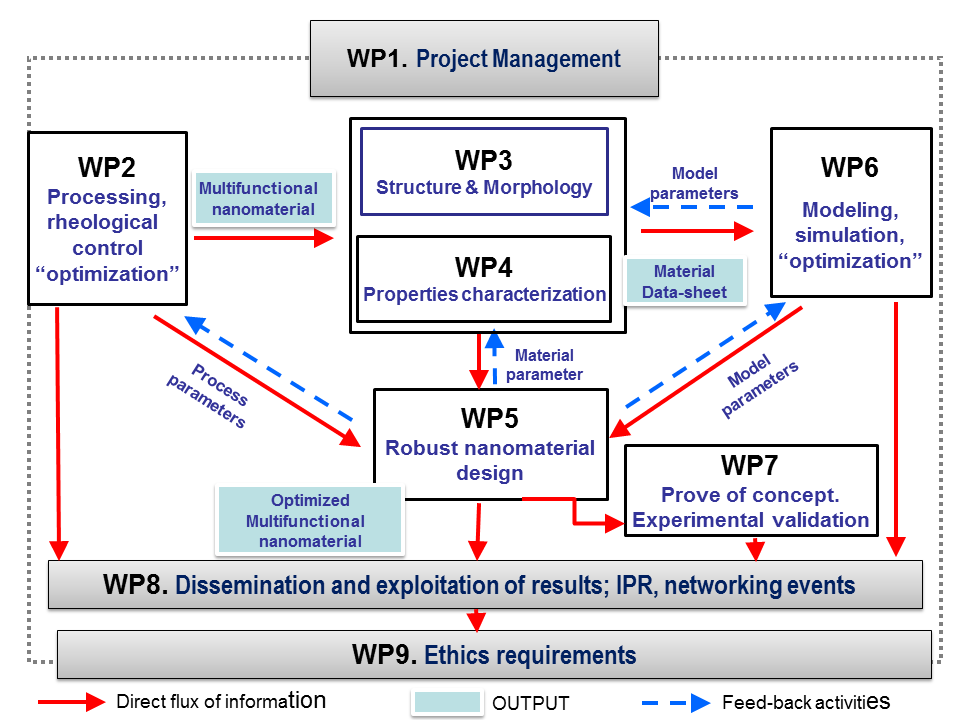Work packages

Work Packages Description
WP1. Project Management and Coordination (M1-M48) |
| Objectives: Organization, coordination, planning and controlling the project in order to accomplish the targeted goals. Overall management, coordination and reporting on the project implementation, secondments and resources |
| Task 1.1. Project coordination and management. Task 1.2. Coordination of secondments. |
| Deliverables: D 1.1. First year progress report (M12) D 1.2. Mid-term meeting, organized within the frame of the First Workshop (M17) D 1.3. Final progress report (M48) |
WP2. Processing and rheological of graphene-based nanocomposites (M1-M36) |
| Objectives: To develop optimal processing procedures for polymer nanocomposites with different types of graphene/CNTs and polymers. To develop rheological methodology for control on the nanocomposite structure. To prepare test samples for other WPs |
| Task 2.1. Materials synthesis and specifications Task 2.2. Nanocomposite processing Task 2.3. Rheological methodology for control of dispersion; rheological percolation threshold Task 2.4. Optimization of production parameters and preparation of test samples |
| Deliverables: D2.1. Materials specifications (M4) D2.2. Rheological methodology, optimized processing (M20) D2.3. Report on Materials synthesis and nanocomposite fabrication (M24) |
WP3. Characterization of nanocomposite hybrid structure and morphology (M6-M40) |
| Objectives: To determine the intrinsic structural characteristics of the dispersed graphene nanosheets and CNTs in the polymer. To analyze the hierarchy of morphology, hybrid structure and interfacial interactions of nanocomposites at micro and nanoscale. To provide Data sheets of essential structural parameters to other WPs. |
| Task 3.1. Characterization of structure and morphology at micro and nanoscale. Task 3.2. Experimental and theoretical characterization of interfacial interactions and dynamics of molecules. |
| Deliverables: D 3.1. Report of essential nanostructure parameters (M35) |
WP4. Characterization of nanocomposite properties around percolation threshold (M12-M44) |
| Objectives: To evaluate reinforcement effects of graphene/carbon nanotube mixture on mechanical, thermal and physical properties of nanocomposites. To determine mechanical percolation and electrical percolation thresholds relating the nanocomposite structure to the properties improvement. To create Data sheet with maximum improved properties of nanocomposites toward specific applications. |
| Task 4.1. Mechanical properties at macro, micro and nano-scale. Task 4.2. Dielectric, electrical, and electromagnetic properties. Task 4.3. Thermal characteristics. Task 4.4. Data sheet of maximum improved nanocomposite properties. |
| Deliverables: D4.1. Data Sheet of maximum improved nanocomposite mechanical, thermal, electrical and electromagnetic properties (M40) |
WP5. Robust nanocomposite design for 3D printing application (M6-M42) |
| Objectives: Based on experimental results from WPs 2, 3 and 4, to exploit the robust design approach for optimization of the processing-structure-property-performance variables. To propose optimal formulation for the graphene based-polymer material, suitable for 3D printing, that has the highest electrical and electromagnetic properties, high thermal conductivity, good processability and cost effectiveness. |
| Task 5.1. Robust nanocomposite design. Task 5.2. Experimental validation of the nanocomposite optimized formulation for 3D printing application. |
| Deliverables: D5.1. Robust nanocomposite design tool (M30) D5.2. Technical specifications of the novel graphene-based polymer material for 3D printing (M38) |
WP6. Modeling and optimization of 3D printed cellular structures with pre-defined properties (M6-M42) |
| Objectives: To design nanocomposite-based cellular structures with optimum configuration (structure, geometry and properties) in view of predefined performances. To define of the best nanocomposite to be used for a given application. To provide a proof of concept for GHz ideal absorbing media for which other properties, such lightness and mechanical strength, will be simultaneously enhanced. |
| Task 6.1 Rigid closed-cell cellular structures. Task 6.2 Permeable open-cell cellular structures. |
| Deliverables: D6.1 Design of foam-like closed-shell structures of 3D-printed materials to be used for electromagnetic shielding, with optimized lightness and mechanical robustness (M23) D6.2 Design of spongy open structures of 3D-printed materials to be used for electromagnetic shielding, with optimized permeability and heat transfer capability (M38) |
WP7. Prove of design concept by experimental validation of cellular structures (M24-M48) |
| Objectives: To elaborate prototypes of 3D printed cellular structures designed and optimized in WP6 using novel nanocomposite material’s formulation from WP5. To validate experimentally mechanical, thermal, electrical and electromagnetic performances of prototypes. To compare experimental characteristics of prototypes with the simulated performance and reduce variations. To define the application specifications of cellular structures |
| Task 7.1. Prototypes of optimized geometries of cellular structures based on nanocomposite material. Task 7.2. Experimental validation of the cellular prototypes and comparison with the model predictions. Task 7.3. Application specification. |
| Deliverables: D7.1. Experimentally validated Laboratory prototypes of 3D printed cellular structures (M42) D7.2. Data sheets with final properties of prototypes; their innovation potential and application specification (M47) |
WP8. Dissemination and exploitation of results, IPR, networking and communication strategy (M1-M48) |
| Objectives: Effective and sustainable dissemination of knowledge among and beyond the members of the consortium; Providing adequate and effective protection of innovation created in the project; Promotion of the exploitation of project results under consideration of the IPR of participants; Coordination of workshops and training activities within the project; Coordination of communication and outreach activities to public; Promotion of international and inter-sectoral long-lasting collaborations by setting up a Joint Laboratory on Graphene/polymer Research. |
| Task 8.1: Website and Flyer. Task 8.2. Dissemination of Project Results. Task 8.3. Networking through project meetings. Task 8.4. Communication strategy and Outreach plan. Task 8.5. Exploitation plan, Patent research and IPR issues. Task 8.6. Set up Joint Laboratory on Graphene/polymer Research. |
| Deliverables: D8.1. Graphene 3D website and Flyer (M3 -M48) D8.2. Report on Dissemination of Project Results; Communication and Outreach plan (M24, M45) D8.3. Report on Meetings and Networking Events (M30, M46) D8.4. Report on Exploitation of Results and IPR (M47) D8.5. Set up Joint Laboratory on graphene-polymer research (M45) |
WP9. Ethics requirements (M1-M48) |
| Objectives: To ensure compliance with the 'ethics requirements' set out in this work package. |
| Deliverables: D9.1 : NEC - Requirement No. 3 (M1) 6.3. The applicant must provide details on the materials which will be imported to/exported from the EU and provide the adequate authorizations. |
